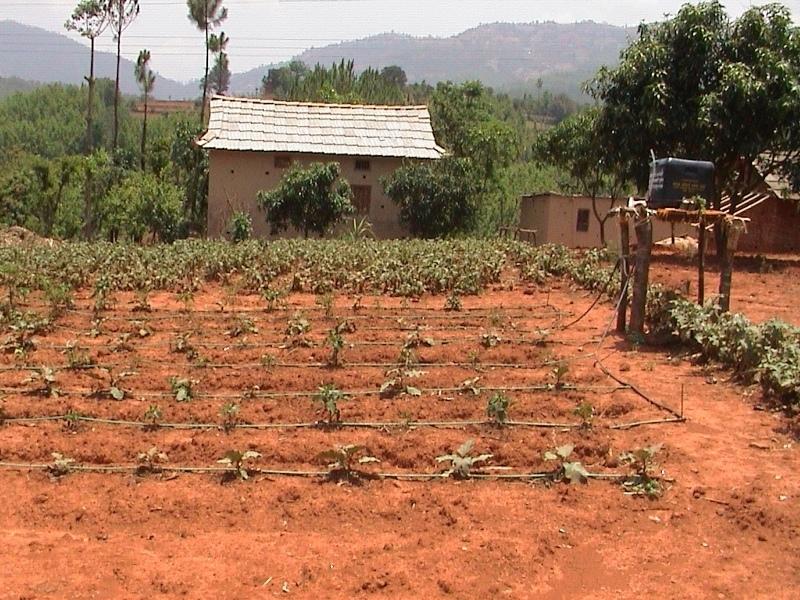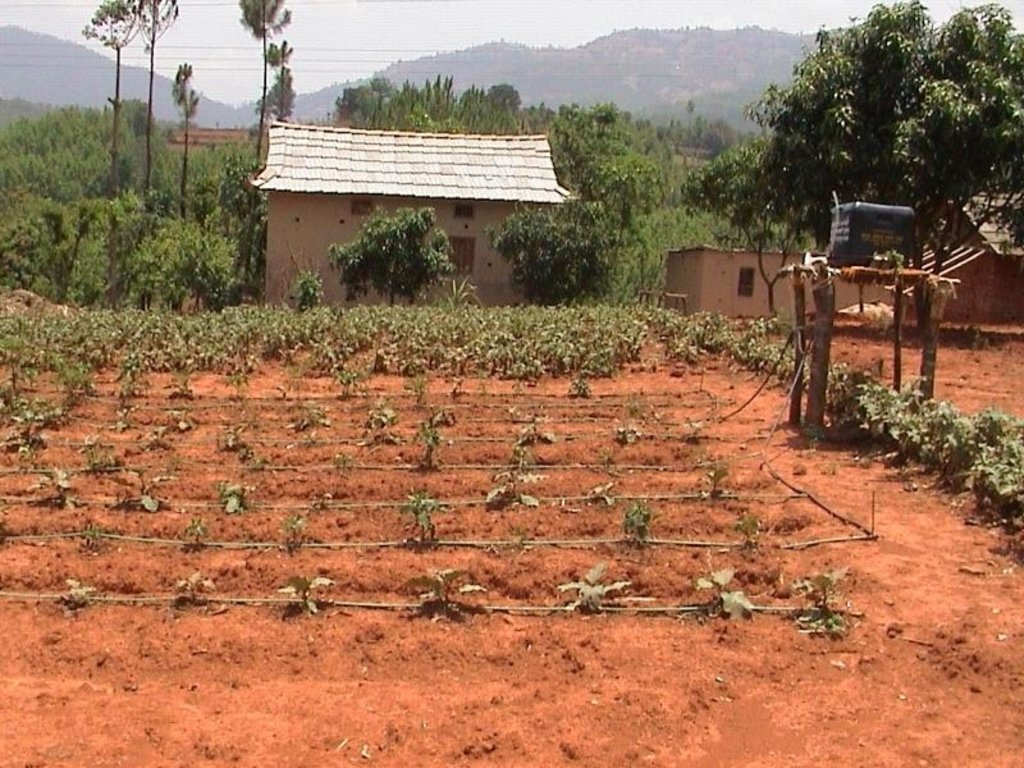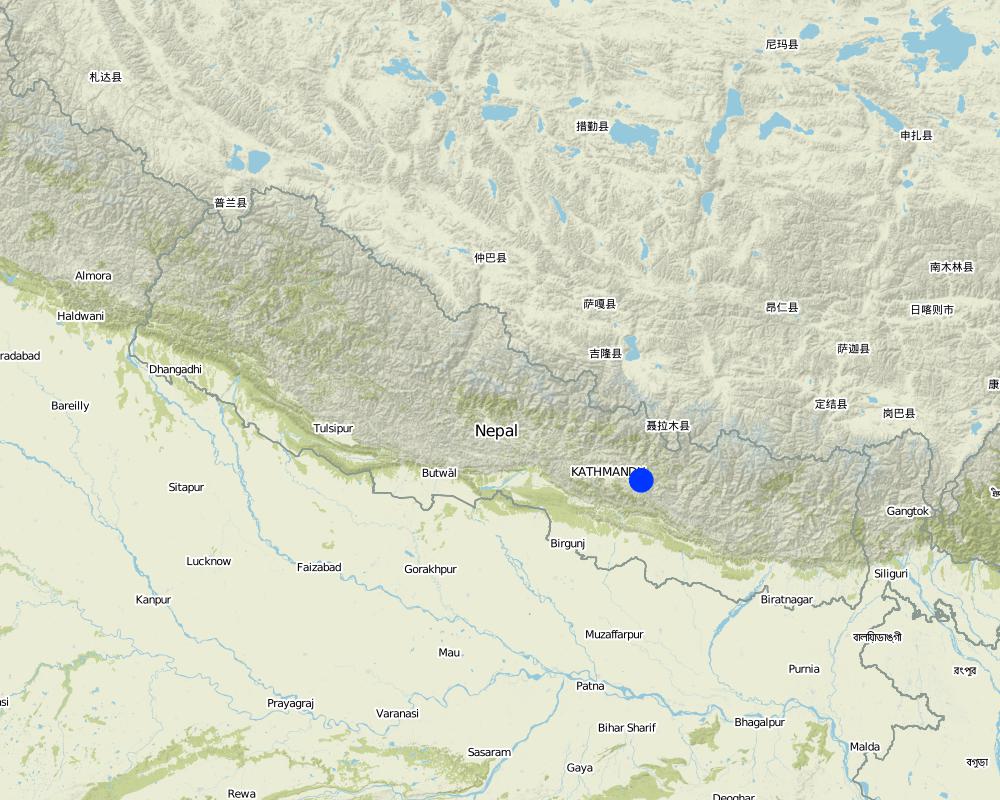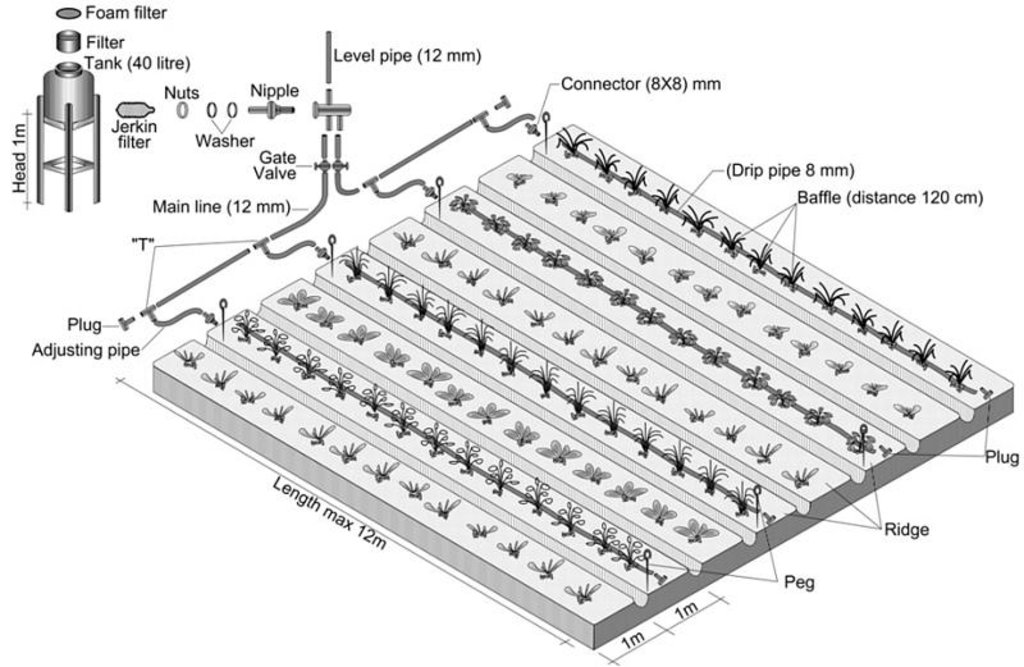Low cost drip irrigation [尼泊尔]
- 创建:
- 更新:
- 编制者: Madhav Dhakal
- 编辑者: –
- 审查者: David Streiff, Alexandra Gavilano
Thopa Sichaee (Nepali)
technologies_1501 - 尼泊尔
查看章节
全部展开 全部收起1. 一般信息
1.2 参与该技术评估和文件编制的资源人员和机构的联系方式
SLM专业人员:
SLM专业人员:
Adhikari Krishna
PARDYP/ICIMOD
尼泊尔
SLM专业人员:
Shrestha-Malla Smita
PARDYP/ICIMOD
尼泊尔
SLM专业人员:
有助于对技术进行记录/评估的项目名称(如相关)
People and Resource Dynamics Project, Nepal (PARDYP)有助于对技术进行记录/评估的机构名称(如相关)
ICIMOD International Centre for Integrated Mountain Development (ICIMOD) - 尼泊尔1.3 关于使用通过WOCAT记录的数据的条件
编制者和关键资源人员接受有关使用通过WOCAT记录数据的条件。:
是
1.5 参考关于SLM方法(使用WOCAT记录的SLM方法)的调查问卷
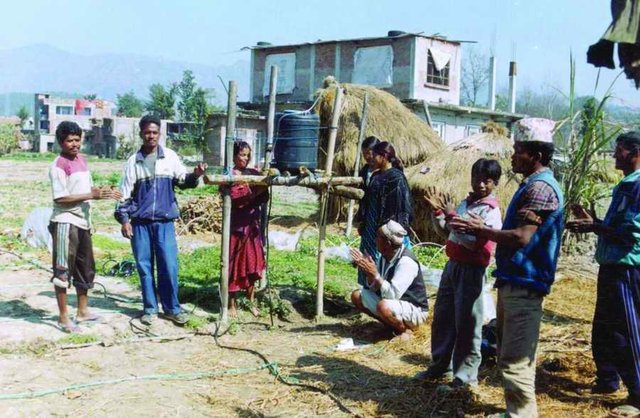
Participatory action research on drip irrigation [尼泊尔]
Conducting participatory action research with farmers and line agencies for demonstrating, disseminating and scaling up drip irrigation.
- 编制者: Madhav Dhakal
2. SLM技术的说明
2.1 技术简介
技术定义:
An irrigation system which allows the slow and precise delivery of water to crops
2.2 技术的详细说明
说明:
Drip irrigation is a very water-efficient irrigation system. Water is dripped to individual plant root zones at low rates (2.25 l/hr) from emitters embedded in small diameter plastic pipes.
Farmers in the Jhikhu Khola watershed, Nepal, suffer from a shortage of water for irrigation between the end of one monsoon (June to September) and the next pre-monsoon period (May). This seriously limits agricultural production and leads to much land being left fallow after the monsoon crops have been harvested. Only a small area is planted with winter crops. The sources of irrigation water (such as rivers, and streams) are limited and the amount of water they provide is inadequate for cropping. Most of the sources remain dry outside the monsoon. Farmers expend considerable time and labour gathering what water they can to irrigate their crops. Low cost drip irrigation (LCDI) has been introduced in the watershed as a cost effective way of making the best use of the limited available water.
The cropping pattern of this area sees pre-monsoon vegetables established in February and March and winter vegetables in September and October. The low cost drip irrigation sets are installed while the fields are being prepared by ploughing, levelling, and ridging. Lateral pipes (12m long) are laid along the ridges which lie 1.5m apart. A wooden platform with storage tank is installed and connected to the lateral pipes. After the lateral pipes are laid out, planting holes are dug along the ridges spaced to coincide with the drip holes. These holes are usually set every 0.6 or 1.2m along the pipes depending on the crop. Farmyard manure and chemical fertiliser is placed in each pit and mixed well with the soil. Next, vegetable seedlings are planted in each hole and daily drip watering begins. Bitter gourd is the most commonly grown crop followed by cauliflower. Irrigation water is generally applied either in the morning or the evening. If needed, stakes are placed next to each plant a week later to allow the plants to climb. The climber crops like bitter gourd are netted one month after planting to provide more space for fruiting. Harvesting starts in mid-May and continues until September. Farmers maintain the system by repairing leaks in the pipe joints and by unblocking blocked drip holes.
2.3 技术照片
2.5 已应用该技术的、本评估所涵盖的国家/地区/地点
国家:
尼泊尔
区域/州/省:
Bagmati zone
有关地点的进一步说明:
Kavepalanchowk/Jhikhu Khola watershed
具体说明该技术的分布:
- 均匀地分布在一个区域
如果不知道精确的区域,请注明大致覆盖的区域:
- < 0.1 平方千米(10 公顷)
注释:
The technology was first introduced in the Jhikhu Khola watershed ( JKW) in 1993 with the support from University of British Columbia (UBC) but due to the technical problems it stopped in the same year. The drip sets introduced for the first time was North American type, and spare parts were not available after malfunctioning. Later on , from Oct. 2000 to Jan.2001, UBC again conducted experiments using two different types of drip sets , i.e. LCDI and Western Type ( Stefanie 2002) This experiment was conducted on Cauliflower. People and Resource Dynamics Project with the collaboration of Institute of engineering , Tribhuban University has initiated the drip experiment on cauliflower in Hokse ( Kubinde) in November 1999. In 2000 and 2001 the drip experiments were conducted on bitter gourd at Horticultural center( Panchkhal). From 2001 onwards it was introduced to the farmers field.
For this study, most of the discussions will be concentrated on Bitter gourd grown under drip in Panchkhal.
Map
×2.6 实施日期
如果不知道确切的年份,请说明大概的日期:
- 不到10年前(最近)
2.7 技术介绍
详细说明该技术是如何引入的:
- 通过项目/外部干预
注释(项目类型等):
Concept of drip irrigation came from Israel. LCDI was introduced by IDE/Nepal
3. SLM技术的分类
3.1 该技术的主要目的
- Reduce water input
3.2 应用该技术的当前土地利用类型

农田
- 一年一作
- 乔木与灌木的种植
年作 - 具体指明作物:
- 谷类 - 大麦
- 谷物类 - 玉米
- 根/块茎作物 - 土豆
- 种子作物 - 芝麻、罂粟、芥末、其他
- 蔬菜 - 其他
- rice, wheat
乔木和灌木种植 - 指定作物:
- 饲料树木(朱缨花属、银合欢、前庭草等)
- 水果、其他
每年的生长季节数:
- 3
具体说明:
Longest growing period in days: 150 Longest growing period from month to month: Jun - Oct Second longest growing period in days: 120 Second longest growing period from month to month: Nov - Feb
注释:
major cash crop: Tomato, potato, vegetables
major food crop: Rice , wheat , maize
other: Mustard, barley, fodder trees, fruit trees
Major land use problems (compiler’s opinion): Insufficient water limits agricultural production during the winter and pre-monsoon seasons (Nov-May) leading to low farm incomes from the small landholdings. The increasing inputs of chemical fertilisers are a matter of concern for environmental protection.
Major land use problems (land users’ perception): Irrigation water shortage for the crops grown during winter and premonsoon months.
Type of cropping system and major crops comments: Rain fed land: Maiz-Wheat /vegetables. Irrigated land: Rice - vegetables/Wheat-vegetabes/ Maize
3.4 供水
该技术所应用土地的供水:
- 雨养
注释:
Water supply: Also mixed rainfed - irrigated
3.5 该技术所属的SLM组
- 灌溉管理(包括供水、排水)
3.6 包含该技术的可持续土地管理措施

管理措施
- M2:改变管理/强度级别
3.7 该技术强调的主要土地退化类型

水质恶化
- Hs:地表水良变化
注释:
Main causes of degradation: urbanisation and infrastructure development (poor irrigation infrastructres), other natural causes (avalanches, volcanic eruptions, mud flows, highly susceptible natural resources, extreme topography, etc.) specify (uneven distribution of precipitation throughout the year.), poverty / wealth (lack of captial - limited fund allocated from government for the irrigation infrastructure development and maintenance), labour availability (lack of labour - out migration for off-farm employment), education, access to knowledge and support services (lack of knowledge - approapriate technologies and the approach to implement them)
Secondary causes of degradation: other human induced causes (specify) (agricultural causes - increased dose of agrochemical use, poor seed qality), land tenure (land subdivision - population growth , separating family members from a household.)
3.8 防止、减少或恢复土地退化
具体数量名该技术与土地退化有关的目标:
- 减少土地退化
4. 技术规范、实施活动、投入和成本
4.1 该技术的技术图纸
技术规范(与技术图纸相关):
Technical parts and design of a low cost drip irrigation system
Location: Jhikhu Khola watershed. Kabrepalanchowk/
Technical knowledge required for field staff / advisors: high
Technical knowledge required for land users: moderate
Main technical functions: increase / maintain water stored in soil, slow and precise delivery of water to plant root zones, enhanced phot*
Secondary technical functions: reduction of evaporation losses*, reduction of water distribution losses*
Change of land use practices / intensity level: from conventional irrigation flood/ bucket) to efficient irrigation
作者:
IDE Nepal
4.2 有关投入和成本计算的一般信息
具体说明成本和投入是如何计算的:
- 每个技术单元
指定单位:
Drip irrigation system
指定单位面积(如相关):
150 square meter
具体说明成本计算所用货币:
- 美元
注明雇用劳工的每日平均工资成本:
2.80
4.3 技术建立活动
| 活动 | 时间(季度) | |
|---|---|---|
| 1. | Connection of the lateral pipes to the water storage tank | February/March |
| 2. | Opening and closing of gate valves | February/March |
| 3. | Levelling of land for uniform water distribution | February/ March ( if required) |
| 4. | Construction of wooden platform to raise the storage tank generally | February/March |
| 5. | Installation of lateral pipes along the ridges/beds;check the spacing | February /March |
| 6. | then dig about 0.5m deep and 0.3m diameter planting pits for | February/March |
4.4 技术建立所需要的费用和投入
| 对投入进行具体说明 | 单位 | 数量 | 单位成本 | 每项投入的总成本 | 土地使用者承担的成本% | |
|---|---|---|---|---|---|---|
| 劳动力 | Labour | Persons/day | 1.0 | 2.8 | 2.8 | 100.0 |
| 设备 | Drip set | unit | 1.0 | 25.8 | 25.8 | |
| 技术建立所需总成本 | 28.6 | |||||
| 技术建立总成本,美元 | 28.6 | |||||
注释:
Duration of establishment phase: 6 month(s)
4.5 维护/经常性活动
| 活动 | 时间/频率 | |
|---|---|---|
| 1. | Prevent leakage by replacing damaged or worn out parts | / as per need |
| 2. | Clean the drip holes with water and a pin | / as per need |
4.6 维护/经常性活动所需要的费用和投入(每年)
| 对投入进行具体说明 | 单位 | 数量 | 单位成本 | 每项投入的总成本 | 土地使用者承担的成本% | |
|---|---|---|---|---|---|---|
| 劳动力 | Cleaning drip holes | Persons/day | 1.43 | 2.8 | 4.0 | 100.0 |
| 设备 | Replacing damaged parts | unit | 1.0 | 300.0 | 300.0 | 100.0 |
| 技术维护所需总成本 | 304.0 | |||||
| 技术维护总成本,美元 | 304.0 | |||||
注释:
Machinery/ tools: spade
The cost is calculated for 150 square meter area , and extrapolated to per hectar of land. Only costs are listed which are additional to the traditional way of growing bitter gourd with out drip. Cost estimated in 2006.
5. 自然和人文环境
5.1 气候
年降雨量
- < 250毫米
- 251-500毫米
- 501-750毫米
- 751-1,000毫米
- 1,001-1,500毫米
- 1,501-2,000毫米
- 2,001-3,000毫米
- 3,001-4,000毫米
- > 4,000毫米
农业气候带
- 潮湿的
Thermal climate class: subtropics
5.2 地形
平均坡度:
- 水平(0-2%)
- 缓降(3-5%)
- 平缓(6-10%)
- 滚坡(11-15%)
- 崎岖(16-30%)
- 陡峭(31-60%)
- 非常陡峭(>60%)
地形:
- 高原/平原
- 山脊
- 山坡
- 山地斜坡
- 麓坡
- 谷底
垂直分布带:
- 0-100 m a.s.l.
- 101-500 m a.s.l.
- 501-1,000 m a.s.l.
- 1,001-1,500 m a.s.l.
- 1,501-2,000 m a.s.l.
- 2,001-2,500 m a.s.l.
- 2,501-3,000 m a.s.l.
- 3,001-4,000 m a.s.l.
- > 4,000 m a.s.l.
关于地形的注释和进一步规范:
Altitudinal zone: 850 m a.s.l.
5.3 土壤
平均土层深度:
- 非常浅(0-20厘米)
- 浅(21-50厘米)
- 中等深度(51-80厘米)
- 深(81-120厘米)
- 非常深(> 120厘米)
土壤质地(表土):
- 中粒(壤土、粉土)
表土有机质:
- 中(1-3%)
- 低(<1%)
如有可能,附上完整的土壤描述或具体说明可用的信息,例如土壤类型、土壤酸碱度、阳离子交换能力、氮、盐度等。:
Soil fertility is medium
Soil drainage / infiltration is good
Soil water storage capacity is medium
5.4 水资源可用性和质量
地表水的可用性:
匮乏/没有
水质(未处理):
不良饮用水(需要处理)
关于水质和水量的注释和进一步规范:
Availability of surface water: More in rainy season (June- September), less in April/May
Water quality (untreated): Also good drinking water but poor in rainy season (June- September), less in April/May source: Natural spring
5.6 应用该技术的土地使用者的特征
生产系统的市场定位:
- 混合(生计/商业)
- 商业/市场
非农收入:
- 收入的10-50%
相对财富水平:
- 贫瘠
- 平均水平
个人或集体:
- 个人/家庭
机械化水平:
- 手工作业
- 畜力牵引
性别:
- 女人
- 男人
说明土地使用者的其他有关特征:
Land users applying the Technology are mainly common / average land users
Population density: 200-500 persons/km2
Annual population growth: 2% - 3%
Off-farm income specification: In most farm households, off-farm income plays at least a minor and increasingly a major role. Occasional opportunities for off-farm income present themselves in the form of daily
Market orientation of production system: The technology is suitable for vegetable farming , most of the farmers grow vegetables commercially because of the good market access.
Level of mechanization: Land cultivation performed mostly with locally available tools like spade and animals are used during land preparation (ploughing)
5.7 应用该技术的土地使用者使用的平均土地面积
- < 0.5 公顷
- 0.5-1 公顷
- 1-2 公顷
- 2-5公顷
- 5-15公顷
- 15-50公顷
- 50-100公顷
- 100-500公顷
- 500-1,000公顷
- 1,000-10,000公顷
- > 10,000公顷
这被认为是小规模、中规模还是大规模的(参照当地实际情况)?:
- 中等规模的
5.8 土地所有权、土地使用权和水使用权
土地所有权:
- 个人,有命名
土地使用权:
- 个人
用水权:
- 自由进入(无组织)
6. 影响和结论性说明
6.1 该技术的现场影响
社会经济效应
收入和成本
农业投入费用
注释/具体说明:
Reduced cost and time for irrigation and applying fertiliser
农业收入
注释/具体说明:
extra income (US$ 700/ha) due to early
工作量
注释/具体说明:
time for irrigation and fertigation reduced, but cropping area increased due to the technology; this increases the workload of women around 0-5%
社会文化影响
社区机构
注释/具体说明:
increased no. of drip users
SLM/土地退化知识
注释/具体说明:
land users become familiar
Livelihood and human well-being
注释/具体说明:
Fallow land used for vegetable production; more income for households.
生态影响
水循环/径流
蒸发
注释/具体说明:
Reduction of water loses through evaporation , percolation
土壤
土壤水分
注释/具体说明:
due to applying water directly to plants’
土壤流失
注释/具体说明:
due to slow and precise delivery of water into the soil
其它生态影响
Mono cropping
注释/具体说明:
majority of farmers grow bitter gourd followed by cauliflower
Technology is not suitable where enough water is available
注释/具体说明:
few farmers abandon the drips
Drip set is not available in local market
注释/具体说明:
there should be provision to get drip sets locally. Presently, every farmer has to approach PARDYP project
6.2 该技术的场外影响已经显现
水资源可用性
注释/具体说明:
less water used to irrigate crops making more
Risk of increased water consumption
注释/具体说明:
Spread of the system could lead to increased upstream water
6.3 技术对渐变气候以及与气候相关的极端情况/灾害的暴露和敏感性(土地使用者认为的极端情况/灾害)
渐变气候
渐变气候
| 季节 | 增加或减少 | 该技术是如何应对的? | |
|---|---|---|---|
| 年温度 | 增加 | 未知 |
气候有关的极端情况(灾害)
气象灾害
| 该技术是如何应对的? | |
|---|---|
| 局地暴雨 | 好 |
| 局地风暴 | 好 |
气候灾害
| 该技术是如何应对的? | |
|---|---|
| 干旱 | 不好 |
水文灾害
| 该技术是如何应对的? | |
|---|---|
| 比较和缓的(河道)洪水 | 不好 |
其他气候相关的后果
其他气候相关的后果
| 该技术是如何应对的? | |
|---|---|
| 缩短生长期 | 好 |
6.4 成本效益分析
技术收益与技术建立成本相比如何(从土地使用者的角度看)?
短期回报:
积极
长期回报:
非常积极
技术收益与技术维护成本/经常性成本相比如何(从土地使用者的角度看)?
短期回报:
非常积极
长期回报:
非常积极
注释:
The practice delivers quick and tangible benefits so that users usually get a return on the cost of investment after only one crop season.
6.5 技术采用
- > 50%
如若可行,进行量化(住户数量和/或覆盖面积):
50 households in an area of 10 ha
在所有采用这项技术的人当中,有多少人是自发的,即未获得任何物质奖励/付款?:
- 51-90%
注释:
58% of land user families have adopted the Technology with external material support
29 land user families have adopted the Technology with external material support
Comments on acceptance with external material support: survey results
42% of land user families have adopted the Technology without any external material support
21 land user families have adopted the Technology without any external material support
Comments on spontaneous adoption: survey results
There is a strong trend towards spontaneous adoption of the Technology
Comments on adoption trend: Farmers have shown growing interest, no. of drip farmers are increasing year by year, about 50 farmers in the watershed are practicing drip till present. Another 55 farmers are also using the technology with the support from a local NGO ( Ranipani Gram Sewa Samitee) District Soil Conservation Office, (DISCO) Kabhre and District Irrigation Office ( DIO) Kabhre. PARDYP is continuously providing technical support for all ( about 105) the drip users, no of drip users will be increased drastically in coming future if it is easily accessible and sufficient technical knowledge provided to them.
6.7 该技术的优点/长处/机会
| 土地使用者眼中的长处/优势/机会 |
|---|
|
Dry season ( off season) vegetable production become possible for the areas having limited sources of water. How can they be sustained / enhanced? Technology should be available in the local market |
| Effective irrigation with little amount of water. |
|
Plant to plant visits are not required while irrigating, so irrigation, fertigation, and weeding take less time – the technology needs 50% less labor compared to bucket irrigation How can they be sustained / enhanced? Experience sharing and interactions among drip users and non-users, easy access to technology with necessary trainings |
| Easy fertilizer application with drip. |
| Women farmers self-esteem was enhanced because of drip as they could grow cash crops alone . |
| 编制者或其他关键资源人员认为的长处/优势/机会 |
|---|
|
Drip irrigation saved 60% of water compared to bucket irrigation; dry season (off-season) vegetable production became possible and cropping area increased on areas with limited access to irrigation water How can they be sustained / enhanced? Construction of water harvesting ponds and the use of collected water in drip systems makes for sustainable crop production |
|
Additional household income (~$700/ha) due to early fruiting in case of bitter gourd (comparative study of drip vs. bucket irrigation) How can they be sustained / enhanced? Options for other potential high value cash crops should be explored |
| Soil moisture lasted for longer period, losses from evaporation reduced. |
6.8 技术的弱点/缺点/风险及其克服方法
| 土地使用者认为的弱点/缺点/风险 | 如何克服它们? |
|---|---|
| The spacing of the drip holes does not match the farmer’s needs | Make pipes available with at least 50 cm distance between drip holes |
| Spare parts are not available in the local market and farmers have to travel far (to Kathmandu) to get spare parts | Make parts available locally |
| Rats damage drip pipe frequently. |
| 编制者或其他关键资源人员认为的弱点/缺点/风险 | 如何克服它们? |
|---|---|
| Technology is not suitable for sloping land and covers only a small area (using a medium-sized kit) | Modifying and levelling slopes and increasing the number of drip kits can overcome this limitation |
| Setup ( fitting) procedure is sophisticated | regular training |
7. 参考和链接
7.1 信息的方法/来源
7.2 参考可用出版物
标题、作者、年份、ISBN:
ICIMOD (2007) Good Practices in Watershed Management, Lessons Learned in the Mid Hills of Nepal. Kathmandu: ICIMOD
可以从哪里获得?成本如何?
ICIMOD
标题、作者、年份、ISBN:
Prajapati-Merz, B. (2003) ‘Drip Irrigation System.’ In PARDYP Annual Report 2003 submitted to ICIMOD, Kathmandu
可以从哪里获得?成本如何?
ICIMOD
标题、作者、年份、ISBN:
Shrestha, S. (2004) Adoption of Drip Technology and It’s Impact on Gender: a Case Study fromJhikhu Khola Watershed, a report submitted to PARDYP project, ICIMOD, Kathmandu, Nepal
可以从哪里获得?成本如何?
ICIMOD
标题、作者、年份、ISBN:
Von Westarp, S. (2002) Agricultural Intensifi cation, Soil Fertility Dynamics, and Low CostDrip Irrigation in the Middle Mountains of Nepal, M.Sc. Thesis. Vancouver: University of British Columbia (UBC)
可以从哪里获得?成本如何?
ICIMOD,UBC Canada
链接和模块
全部展开 全部收起链接

Participatory action research on drip irrigation [尼泊尔]
Conducting participatory action research with farmers and line agencies for demonstrating, disseminating and scaling up drip irrigation.
- 编制者: Madhav Dhakal
模块
无模块


